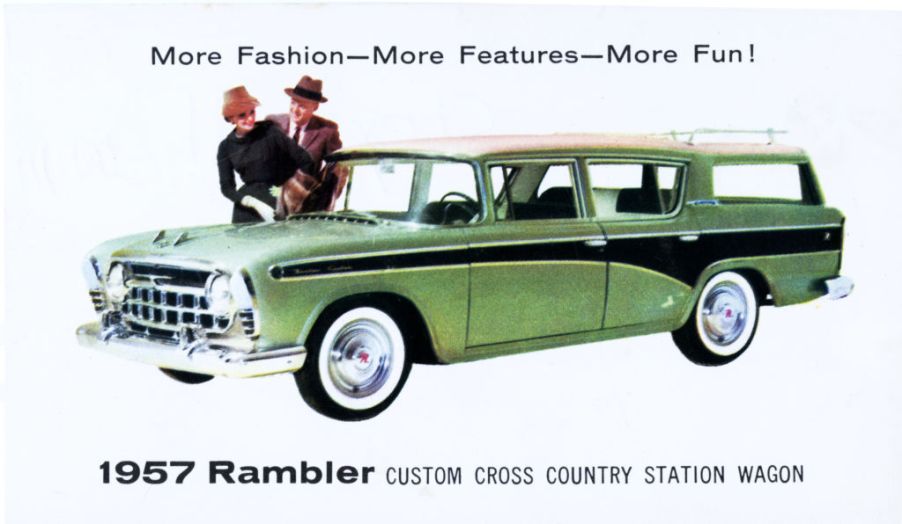
Why Is a Station Wagon Called a Station Wagon?
The next time you’re in a car dealership, just say the words “station wagon” and you’re likely to be corrected instantly. Almost no manufacturer wants to use the “w” word to describe their crossovers, SUVs, MPVs, or even Family Trucksters. But the station wagon has a long and proud history that many manufacturers should be proud of. They were called station wagons because they were initially designed to ferry the rich and famous to and from a train station.
The first station wagons were special versions of regular cars

Before the jet age most people traveled by train, with lots of luggage. There was a need at the time for cars that could ferry people to the train station with their trunks and carpet bags, so custom builders invented the “depot hack.” Essentially, the depot hack was a regular car with more room for luggage, and these were special high-end cars that the well-heeled would call to take them to a station.
Before the jet age most people traveled by train, with lots of luggage. There was a need at the time for cars that could ferry people to the train station with their trunks and carpet bags, so custom builders invented the “depot hack.” Essentially, the depot hack was a regular car with more room for luggage, and these were special high-end cars that the well-heeled would call to take them to a station.
By the late 1920s, according to The Atlantic, General Motors was the first manufacturer to jump on the trend and created The Star Car, the first true station wagon for taking people to train stations. By the 1930s, wood-bodied special versions of regular cars and trucks were common, and they were the first SUVs with luxurious interiors and go-anywhere suspensions that were designed for tough passenger duty. Once iconic roads like Route 66 were paved in the 1950s, Americans wanted to see the country by car, and the station wagon became the best way to take several people on a weeks-long vacation.
We would not have modern crossovers without the station wagon

The modern crossover is, in many ways, just a tall station wagon. We get it, nobody wants to hear the “w” word, especially brands like Subaru or Mazda, who have called their wagons crossovers or SUVs for years. But, wagons like the Subaru Forester and the Mazda CX-5 carry on the tradition of car-like handling with a lot of carrying capacity in back.
We all still want the ability to carry lots of luggage in the back, we just don’t want the Clark Griswold image. By the late 1990s, station wagons were on their way out as people started to recognize that SUVs offered the same utility, but a higher seating position and they ditched that 1980s “Stranger Things” vibe. But now, it seems, the automotive world may be coming back to the wagon as more people realize that tall, brick-like, SUVS get terrible gas mileage, aren’t more capable, and many now have the same image that a Ford Country Squire did in the 1990s.
Some wagons are cool again


There are always folks who go against the grain. For those folks, station wagons are cool again. They are, after all, as practical but more fuel efficient than an SUV. Also, it’s nice to walk up to a car in a parking lot that doesn’t look like every other car in the lot. While Buick killed the last American station wagon the Buick TourX, European luxury makers still produce cool wagons.
Luxury brands are refusing to give up on the wagon, with Volvo and Mercedes-Benz leading the way. Volvo isn’t shying away from the w-word, but is leaning into it instead. It proudly calls the new V60 and V90 Estates and Family Wagons, and it’s tossing in the latest tech, too. The $70,550 V60 Recharge is a plug-in hybrid version, for example, while the $58,450 Cross Country offers all-wheel drive and a funky minimalist interior.
Mercedes-Benz, too, knows that its GLC SUV is its best-selling vehicle, but it’s not leaving out wagon fans with the $68,400 E-Class Wagon. Yes, it uses the w-word right in the name. The E-Class Wagon combines all of the goodness of Mercedes’s midsize E-Class car with the functionality of a wagon. It comes with a 362 horsepower six-cylinder and can accelerate to 60 mph in 5.3 seconds, per Mercedes. It also looks good and because of its car-like proportions will handle better on long family trips than a tall SUV.


